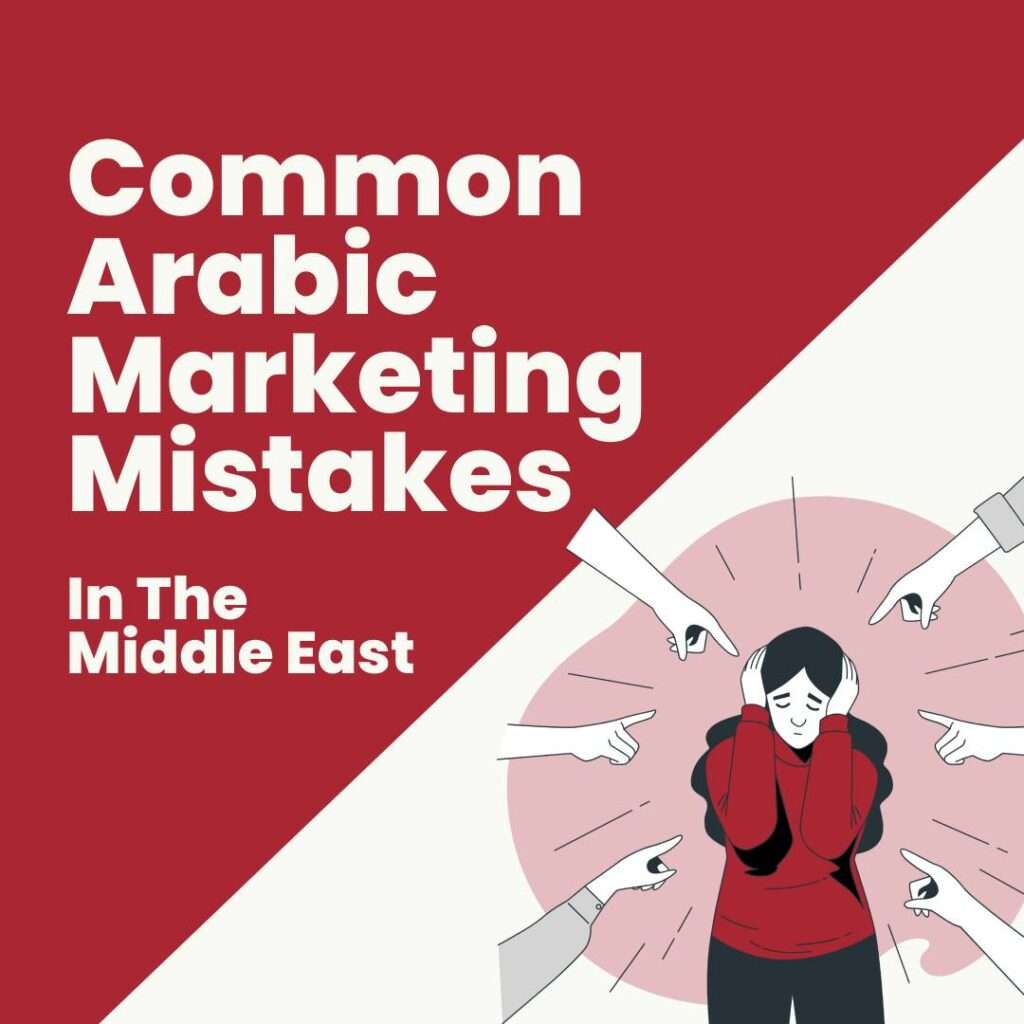Common Arabic Marketing Mistakes
One of the biggest mistakes companies make when expanding to the Middle East region is assigning the Arabic marketing responsibilities to managers who have never worked in this region before. It is important to have a native market experts who know the language, the culture and the customer behavior’s to be involved in the translation, localization, content and targeting process to ensure that the message is conveyed accurately and effectively, as otherwise, you risk failing in your marketing efforts.
The Middle East is a unique market and is not similar to European, American, or Asian markets. Therefore, it is important to understand how to succeed in Arab countries and avoid common business mistakes. Some of these mistakes are outlined below;

Not taking culture and religion into account
A company can face major repercussions from forgetting to pay attention to local culture and religion. Just because a product or service you offer doesn’t raise any concerns in Europe or the United States doesn’t mean it won’t in the Middle East. With many countries in the Middle East holding strongly to conservative values and traditions is not that hard to offend someone in the region.
Nike had to recall a pair of shoes that they made that unintentionally appear to have the name Allah (God in Arabic) written on the back of the shoes. Cross-cultural specialists should always be consulted with to avoid these kinds of mistakes.
In 2015, Pringle’s made one of the biggest marketing mistakes ever when they launched a campaign for Ramadan in Muslim countries promoting their new product with grilled bacon flavor. If you have any knowledge about Muslims, you should know that bacon and pork are strictly forbidden by religion, and Ramadan is the most religious event for Muslims.
Not translating your site into Arabic
If your website isn’t available in the your audiences first language there is a high likelihood they will not end up converting or buying something on your site! Regardless of whether or not your targeted audience speaks English in addition to Arabic they most likely prefer reading content in their native tongue.
It is important to avoid direct or robot translations like Google Translate when translating marketing materials into Arabic and instead adapt the message to be culturally appropriate and relevant for the target audience.
Not adapting the design and content for Arabic Language
The Arabic language is written from right to left, so it is important to take this into account when designing marketing materials. This includes making sure that the layout is suitable for the Arabic language and that text is aligned correctly.
Both text direction and text align should be set to Right-to-Left (RTL) while optimizing the content.
We Know how to do it!
Let Us Help You Avoid Marketing Mistakes in the Middle East.
We are an European based Arabic marketing agency specialist in targeting the Middle East and North Africa region and acquiring Arabic speaking customers worldwide. As an Arab focused agency we obsess about understanding Arab behaviour online and offline. Having worked successfully with a variety of businesses in Europe, United Kingdom, and United States to increase their sales the MENA region, we know the strategies, tactics, and channels that can bring you success too.
Contact us
Why Do You Need a Native and Specialist Arabic Marketing Agency For Your Business?
Arabic Marketing Agency Company
Know More About Arabic Marketing
Marketing in Arabic-speaking regions requires a deep understanding of cultural, linguistic, and social nuances. Avoiding common mistakes helps build trust, ensures that your message resonates with the target audience, and prevents potential damage to your brand’s reputation.
Poor translation can distort your message, leading to confusion or offense. It can also make your brand appear unprofessional and disconnected from the local market. Investing in high-quality, culturally aware translation services is crucial for success.
Cultural context is vital in Arabic marketing as it influences how messages are perceived. Understanding local traditions, values, and social norms ensures that your campaign is respectful and relevant, thereby increasing its effectiveness.
Culture and religion are deeply intertwined in many Arab societies and can significantly affect consumer behavior and preferences. Respecting Islamic values, understanding religious holidays, and aligning your messaging with cultural norms are essential for creating a positive brand image.
The choice of dialect depends on your target audience. Modern Standard Arabic (MSA) is widely understood across the Arab world, but using a specific regional dialect can create a stronger connection with a local audience. Researching your target demographic will help you make an informed decision.
Arabic typography is crucial because it affects readability and visual appeal. Using inappropriate fonts or poor design choices can make your content difficult to read or unappealing, detracting from your overall message.
To ensure your campaign resonates, conduct thorough market research, understand local cultural and linguistic nuances, work with native speakers, and test your content with focus groups from the target audience.
Not localizing your content can lead to misunderstandings, reduced engagement, and even brand damage. Your marketing efforts may fail to connect with the audience, resulting in wasted resources and missed opportunities.
